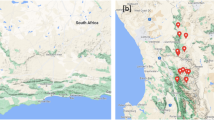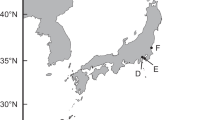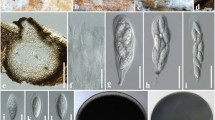Abstract
Toads of the genus Bufo synthesize and accumulate bufadienolides (BDs) in their parotoid glands. BDs are cardiotonic steroids that play an important role in defense against the toads’ predators. Three bufonid taxa occur in mainland Japan, Bufo japonicus formosus, B. j. japonicus, and B. torrenticola. The chemical structures of BDs isolated from B. j. formosus were studied several decades ago, but there is no further information on the toxic components of Japanese toads and their metabolism. In this study, we analyzed BDs of toads from throughout Japan and compared the BD profiles by liquid chromatography/mass spectrometry (LC/MS) and hierarchical cluster analysis (HCA). We observed BDs in three taxa of Japanese toads, and identified five of the most common BDs by nuclear magnetic resonance (NMR) analyses. Of the five BDs, only bufalin was detected in all individuals. HCA of individual BD profiles divided the three taxa into five primary clusters and several subclusters. This result indicates that BD profiles differ both among and within the taxa. The clustering pattern of BDs is generally concordant with a phylogenetic tree reconstructed from the mitochondrial cytochrome b gene of Japanese toads. Our results suggest that the BDs of Japanese toads have diversified not in response to specific selective pressures, but simply due to population structuring over evolutionary time.






Similar content being viewed by others
Data Availability
Uploading and archiving of auxiliary data files is not required as all data related to this manuscript is contained in the supplementary material.
References
Barbosa CM, Medeiros MS, Riani Costa CCM, Camplesi AC, Sakate M (2009) Toad poisoning in three dogs: case reports. J Venom Anim Toxins 15:789–798. https://doi.org/10.1590/S1678-91992009000400016
Brodie ED III, Brodie ED Jr (1999) Predator-prey arms races: asymmetrical selection on predators and prey may be reduced when prey are dangerous. BioScience 49:557–568. https://doi.org/10.2307/1313476
Casewell NR, Wüster W, Vonk FJ, Harrison RA, Fry BG (2013) Complex cocktails: the evolutionary novelty of venoms. Trends Ecol Evol 28:219–229. https://doi.org/10.1016/j.tree.2012.10.020
Chen C, Osuch MV (1969) Biosynthesis of bufadienolides–3β-hydroxycholanates as precursors in Bufo marinus bufadienolides synthesis. Biochem Pharmacol 18:1797–1802. https://doi.org/10.1016/0006-2952(69)90273-1
Córdova WHP, Leitao SG, Cunha-Filho G, Bosch RA, Alonso IP, Pereda-Miranda R, Gervou R, Touza NA, Quintas LEM, Noel F (2016) Bufadienolides from parotoid gland secretions of Cuban toad Peltophryne fustiger (Bufonidae): inhibition of human kidney Na+/K+-ATPase activity. Toxicon 110:27–34. https://doi.org/10.1016/j.toxicon.2015.11.015
Dumbacher JP, Wako A, Derrickson SR, Samuelson A, Spande TF, Daly JW (2004) Melyrid beetles (Choresine): a putative source for the batrachotoxin alkaloids found in poison-dart frogs and toxic passerine birds. Proc Natl Acad Sci U S A 101:15857–15860. https://doi.org/10.1073/pnas.0407197101
Green B, Crane RI, Khaidem IS, Leighton RS, Newaz SS, Smyser TE (1985) Synthesis of steroidal 16, 17-fused unsaturated–lactones. J Org Chem 50:640–644. https://doi.org/10.1021/jo00205a016
Hanifin CT (2010) The chemical and evolutionary ecology of tetrodotoxin (TTX) toxicity in terrestrial vertebrates. Mar Drugs 8:577–593. https://doi.org/10.3390/md8030577
Hase K, Shimada M, Nikoh N (2012) High degree of mitochondrial haplotype diversity in the Japanese common toad Bufo japonicus in urban Tokyo. Zool Sci 29:702–708. https://doi.org/10.2108/zsj.29.702
Hashimoto N, Aoyama T, Shiori T (1981) A simple efficient preparation of methyl esters with trimethylsilyldiazomethane (TMSCHN) and its application to gas chromatographic analysis of fatty acids. Chem Pharm Bull 29:1475–1478. https://doi.org/10.1248/cpb.29.1475
Hirai T, Matsui M (2002) Feeding ecology of Bufo japonicus formosus from the montane region of Kyoto, Japan. J Herpetol 36:719–723. https://doi.org/10.1670/0022-1511(2002)036[0719:FEOBJF]2.0.CO;2
Hostetler JR, Cannon MS (1974) The anatomy of the parotoid gland in Bufonidae with some histochemical findings. J Morphol 142:225–239. https://doi.org/10.1002/jmor.1051420208
Hutchinson DA, Mori A, Savitzky AH, Burghardt GM, Wu X, Meinwald J, Schroeder FC (2007) Dietary sequestration of defensive steroids in nuchal glands of the Asian snake Rhabdophis tigrinus. Proc Natl Acad Sci U S A 104:2265–2270. https://doi.org/10.1073/pnas.0610785104
Hutchinson DA, Savitzky AH (2004) Vasculature of the parotoid glands of four species of toads (Bufonidae: Bufo). J Morphol 260:247–254. https://doi.org/10.1002/jmor.10219
Igawa T, Kurabayashi A, Nishioka M, Sumida M (2006) Molecular phylogenetic relationship of toads distributed in the Far East and Europe inferred from the nucleotide sequences of mitochondrial DNA genes. Mol Phylogenet Evol 38:250–260. https://doi.org/10.1016/j.ympev.2005.09.003
Irwin DM, Kocher TD, Wilson AC (1991) Evolution of the cytochrome b gene of mammals. J Mol Evol 32:128–144. https://doi.org/10.1007/BF02515385
Kamano Y, Kotake A, Hashima H, Inoue M, Morita H, Takeya K, Itokawa H, Nandachi N, Segawa T, Yukita A, Saitou K, Katsuyama M, Pettit GR (1998) Structure-cytotoxic activity relationship for the toad poison bufadienolides. Bioorg Med Chem 6:1103–1115. https://doi.org/10.1016/S0968-0896(98)00067-4
Kamano Y, Yamashita A, Nogawa T, Morita H, Takeya K, Itokawa H, Segawa T, Yukita A, Saito K, Katsuyama M, Pettit GR (2002) QSAR evaluation of the Ch’an Su and related bufadienolides against the colchicine-resistant primary liver carcinoma cell line PLC/PRF/51. J Med Chem 45:5440–5447. https://doi.org/10.1021/jm0202066
Kodinariya TM, Makwana PR (2013) Review on determining number of cluster in k-means clustering. IJCSMS 1:90–95 ISSN: 2321–7782
König E, Bininda-Emondsa ORP, Shaw C (2015) The diversity and evolution of anuran skin peptides. Peptides 63:96–117. https://doi.org/10.1016/j.peptides.2014.11.003
Licht LE, Low B (1968) Cardiac response of snakes after ingestion of toad parotoid venom. Copeia 1968:547–551. https://www.jstor.org/stable/1442023
Lichtstein D, Samuelov S, Gati I, Wechter WJ (1992) Digitalis-like compounds in animal tissues. J Basic Clin Physiol Pharmacol 3:269–292. https://doi.org/10.1515/JBCPP.1992.3.4.269
Liu H, Chen SY, Guo JY, Su P, Qiu YK, Ke CH, Feng DQ (2018) Effective natural antifouling compounds from the plant Nerium oleander and testing. Int Biodeterior Biodegradation 127:170–177. https://doi.org/10.1016/j.ibiod.2017.11.022
Martin AP, Palumbi SR (1993) Protein evolution in different cellular environments: cytochrome b in sharks and mammals. Mol Biol Evol 10:873–891. https://doi.org/10.1093/oxfordjournals.molbev.a040047
Marutho D, Handaka SH, Wijaya E, Muljono (2018) The determination of cluster number at k-mean using elbow method and purity evaluation on headline news (2018) 2018 Int'l Seminar on App for Tech of Info and Comm, Semarang: 533–538. https://ieeexplore.ieee.org/stamp/stamp.jsp?tp=&arnumber=8549751
Matsui M (1984) Morphometric variation analyses and revision of the Japanese toads (genus Bufo, Bufonidae). Contr Biol Lab Kyoto Univ 26:209–428. http://hdl.handle.net/2433/156031
Matsui M, Maeda N (2018) Encyclopaedia of Japanese frogs. Bun-ichi Sogo Shuppan, Tokyo
Mebs D (2001) Toxicity in animals. Trends in evolution? Toxicon 39:87–96. https://doi.org/10.1016/S0041-0101(00)00155-0
Mohammadi S, Petschenka G, French SS, Mori A, Savitzky AH (2018) Snakes exhibit tissue-specific variation in cardiotonic steroid sensitivity of Na+/K+-ATPase. Comp Biochem Physiol B 217:21–26. https://doi.org/10.1016/j.cbpb.2017.11.014
Mori A, Burghardt GM, Savitzky AH, Roberts KA, Hutchinson DA, Goris RC (2012) Nuchal glands: a novel defensive system in snakes. Chemoecology 22:187–198. https://doi.org/10.1007/s00049-011-0086-2
Porto AM, Baralle FE, Gros EG (1972) Biosynthesis of bufadienolides in toads: III–experiments with [2-14C] mevalonic acid, [20-14C] 3β-hydroxy-5-pregnen-20-one and [20-14C] cholesterol. J Steroid Biochem 3:11–17. https://doi.org/10.1016/0022-4731(72)90006-4
Roelants K, Fry BG, Norman JA, Clynen E, Schoofs L, Bossuyt F (2010) Identical skin toxins by convergent molecular adaptation in frogs. Curr Biol 20:125–130. https://doi.org/10.1016/j.cub.2009.11.015
Shibata H, Chijiwa T, Oda-Ueda N, Nakamura H, Yamaguchi K, Hattori S, Matsubara K, Matsuda Y, Yamashita A, Isomoto A, Mori K, Tashiro K, Kuhara S, Yamasaki S, Fujie M, Goto H, Koyanagi R, Takeuchi T, Fukumaki Y, Ohno M, Shoguchi E, Hisata K, Satoh N, Ogawa T (2018) The habu genome reveals accelerated evolution of venom protein genes. Sci Rep 8:11300 https://www.nature.com/articles/s41598-018-28749-4.pdf
Shimada K, Fujii Y, Mitsuishi E, Nambara T (1974) Isolation of a new type bufotoxin from skin of Bufo vulgaris formosus Boulenger. Tetrahedron Lett 15:467–468. https://doi.org/10.1016/S0040-4039(01)82245-0
Shimada K, Sato Y, Fujii Y, Nambara T (1976) Occurrence of bufalitoxin, cinobufotoxin and their homologs in Japanese toad. Chem Pharm Bull 24:1118–1120. https://doi.org/10.1248/cpb.24.1118
Shimada K, Fujii Y, Yamashita E, Niizaki Y, Sato Y, Nambara T (1977) Studies on cardiotonic steroids from the skin of Japanese toad. Chem Pharm Bull 25:714–730. https://doi.org/10.1248/cpb.25.714
Shimada K, Ohishi K, Nambara T (1984) Isolation and characterization of new bufotoxins from the skin of Bufo melanostictus Schneider. Chem Pharm Bull 32(11):4396–4401
Shimada K, Ro JS, Kanno C, Nambara T (1987) Occurrence of bufogenin conjugates in the skin of Korean toad. Chem Pharm Bull 35(12):4996–4999
Steyn PS, van Heerden FR (1998) Bufadienolides of plant and animal origin. Nat Prod Rep 15:397–413. https://pubs.rsc.org/en/content/articlepdf/1998/np/a815397y
Syakur MA, Khotimah BK, Rochman EMS, Satoto BD (2018) Integration k-means clustering method and elbow method for identification of the best customer profile cluster. Iop Conf Ser Mater Sci Eng 336:012017. https://iopscience.iop.org/article/10.1088/1757-899X/336/1/012017/pdf
Takada W, Sakata T, Shimano S, Enami Y, Mori N (2005) Scheloribatid mites as the source of pumiliotoxins in dendrobatid frogs. J Chem Ecol 31:2403–2415. https://doi.org/10.1007/s10886-005-7109-9
Tian HY, Zhang PW, Liu JS, Zhang DM, Zhang XQ, Jiang RW, Ye WC (2014) New cytotoxic C-3 dehydrated bufadienolides from the venom of Bufo bufo gargarizans. Chin Chem Lett 25:1104–1106. https://doi.org/10.1016/j.cclet.2014.02.006
Toledo RC and Jared C (1995) Cutaneous granular glands and amphibian venoms. Comp Biochem Phys A 111: 1–29. https://doi.org/10.1016/0300-9629(95)98515-I
Wei WL, Hou JJ, Wang X, Yu Y, Li HJ, Li ZW, Feng ZJ, Qu H, Wu WY, Guo DA (2019) Venenum bufonis: an overview of its traditional use, natural product chemistry, pharmacology, pharmacokinetics and toxicology. J Ethnopharmacol 237:215–235. https://doi.org/10.1016/j.jep.2019.03.042
Williams BL, Brodie ED Jr, Brodie ED III (2003) Coevolution of deadly toxins and predator resistance: self-assessment of resistance by garter snakes leads to behavioral rejection of toxic newt prey. Herpetologica 59:155–163. https://doi.org/10.1655/0018-0831(2003)059[0155:CODTAP]2.0.CO;2
Williams BL, Brodie ED Jr, Brodie ED III (2004) A resistant predator and its toxic prey: persistence of newt toxin leads to poisonous (not venomous) snakes. J Chem Ecol 30:1901–1919. https://doi.org/10.1023/B:JOEC.0000045585.77875.09
Yamazaki Y, Kouketsu S, Fukuda T, Araki Y, Nambu H (2008) Natural hybridization and directional introgression of two species of Japanese toads Bufo japonicus formosus and Bufo torrenticola (Anura: Bufonidae) resulting from changes in their spawning habitat. J Herpetol 42:427–436. https://doi.org/10.1670/07-186.1
Yang Q, Zhou X, Zhang M, Bi L, Miao S, Cao W, Xie Y, Sun J, Tang H, Li Y, Miao Q, Wang S (2015) Angel of human health: current research updates in toad medicine. Am J Transl Res 7: 1–14. https://www.ncbi.nlm.nih.gov/pmc/articles/PMC4346519/pdf/ajtr0007-0001.pdf
Yoshida T, Ujiie R, Savitzky AH, Jono T, Inoue T, Yoshinaga N, Aburaya S, Aoki W, Takeuchi H, Ding L, Chen Q, Cao C, Tsai TS, de Silva A, Mahaulpatha D, Nguyen TT, Tang Y, Mori N, Mori A (2020) Dramatic dietary shift maintains sequestered toxins in chemically defended snakes. Proc Natl Acad Sci U S A 117:5964–5969. https://doi.org/10.1073/pnas.1919065117
Zhao HY, Wu FK, Qiu YK, Wu Z, Jiang YT, Chen JY (2010) Studies on cytotoxic constituents from the skin of the toad Bufo bufo gargarizans. J Asian Nat Prod Res 12:793–800. https://doi.org/10.1080/10286020.2010.505187
Acknowledgments
We thank many colleagues for collecting toads in Japan. (JSPS) and National Natural Science Foundation of China (NSFC 31411140033) and from.
Funding
This research was supported by grants from Japan-China Joint Research Project (2014–2016) from the Japan Society for the Promotion of Science (JSPS) and National Natural Science Foundation of China (NSFC 31411140033) and from JSPS KAKENHI Grant Numbers JP26440213, JP17H03719, and JP18KK0205. Additional funding was provided by Utah State University.
Author information
Authors and Affiliations
Contributions
Conceptualization: Inoue T, Nakata R, Savitzky AH, Yoshinaga N, Mori A, Mori N.
Data curation: Inoue T, Nakata R, Savitzky AH, Yoshinaga N, Mori A, Mori N.
Formal analysis: Inoue T, Nakata R, Yoshinaga N, Mori N.
Funding acquisition: Mori A.
Investigation: Inoue T, Nakata R, Savitzky AH, Mori A, Mori N.
Methodology: Inoue T, Nakata R, Yoshinaga N, Mori A, Mori N.
Project administration: Inoue T, Nakata R, Mori A, Mori N.
Resources: Inoue T, Mori A.
Supervision: Inoue T, Nakata R, Savitzky AH, Yoshinaga N, Mori A, Mori N.
Validation: Inoue T, Nakata R, Yoshinaga N, Mori A, Mori N.
Visualization: Inoue T, Nakata R, Savitzky AH, Yoshinaga N, Mori A, Mori N.
Writing – original draft: Inoue T, Nakata R.
Writing – review & editing: Inoue T, Nakata R, Savitzky AH, Mori A, Mori N.
All authors approved the manuscript to be published and agree to be accountable for all aspects of the work in ensuring that questions related to the accuracy or integrity of any part of the work are appropriately investigated and resolved.
Corresponding author
Ethics declarations
Conflict of Interest
Not applicable.
Ethics Approval
The present study was carried out in compliance with the guidelines of the Animal Care and Use Committee of Kyoto University.
Consent to Participate
Not applicable.
Consent for Publication
We consent to publication.
Code Availability
Not applicable
Rights and permissions
About this article
Cite this article
Inoue, T., Nakata, R., Savitzky, A.H. et al. Variation in Bufadienolide Composition of Parotoid Gland Secretion From Three Taxa of Japanese Toads. J Chem Ecol 46, 997–1009 (2020). https://doi.org/10.1007/s10886-020-01217-y
Received:
Revised:
Accepted:
Published:
Issue Date:
DOI: https://doi.org/10.1007/s10886-020-01217-y




